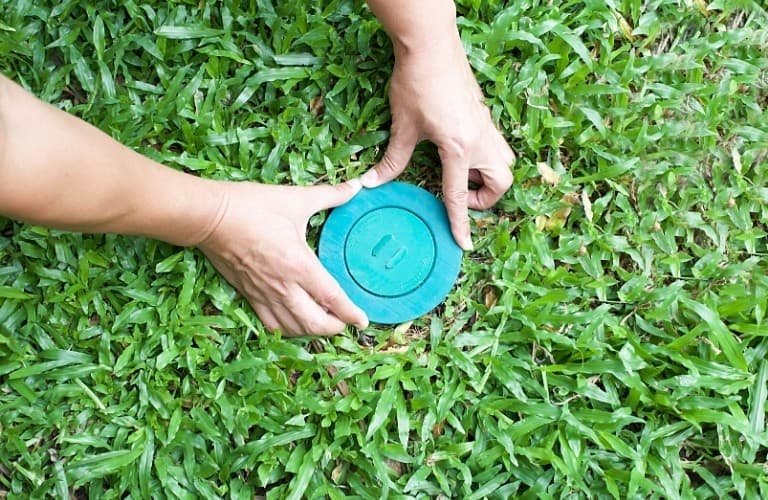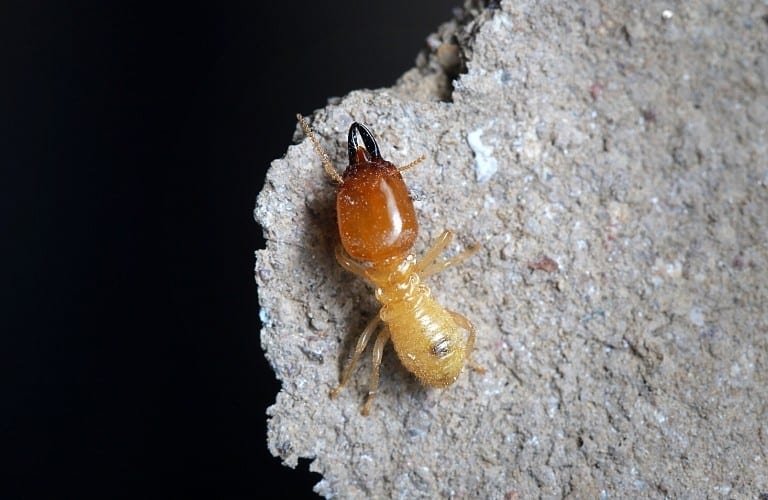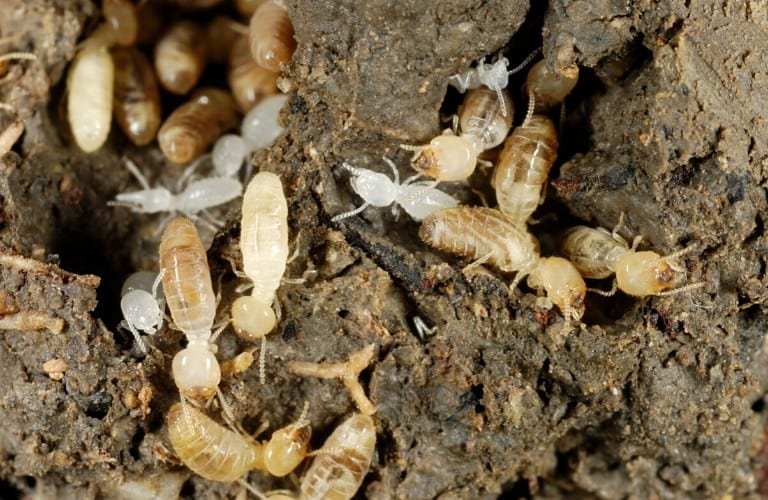Termite bait stations are the preferred form of termite control for many people. The bait draws termites away from your home and eventually kills them.
For those who choose not to employ the services of termite control companies, bait stations are a valid and affordable choice.
What are the best termite bait stations? The best termite bait stations have early detection systems that will alert you to the presence of termite activity and contain in-ground stakes to be filled with bait and pesticides that foraging termites will bring back to the nest to wipe out the entire colony.
Termite treatment varies from home to home. In this article, we’ll show you how to prevent termites and which bait stations work best.
We’ll also show you some other methods of termite control you can use indoors since bait stations are meant for outdoor usage.
Learn how to prevent and eliminate termites like a pro. Click here to find prevention guidelines, the best products available, and DIY elimination strategies.
Best Practices for Preventing an Infestation
Identifying Termites
Termites are usually mistaken for ants because they look similar. However, termites are actually in the same family as cockroaches.
Their abdomens usually resemble a cockroach’s, and they like to stay out of the sun.
The wings on winged termites are all the same size, but a winged ant’s wings are different sizes.
(It’s actually fairly easily to differentiate between termites and winged ants if you know what to look for. Learn how to tell them apart in our article here.)
In the image above, note the straight antennae (not bent like an ant’s) and the broad body shape that lacks a pinched waist – key identifying features.
You can easily tell the difference between termites and ants based on their behavior. A termite eats wood and will make mud tunnels between wood sources.
Termites don’t usually bite, but many species of ants will.
Ants won’t avoid the sun, and they eat carbs and sugar, so they’ll head toward almost any kind of food crumbs.
Carpenter ants drill holes into wood, but because they don’t eat it, you’ll see sawdust around their wood nests.
(See our full lineup of ant articles here for prevention methods and elimination techniques.)
Basic Guidelines
Termite prevention is easily done when the house is being built, but it’s not too late for you if your home is already finished.
Prevention is a constant work in progress. Here are a few things you can start doing today, even if you already have termites around your home.
(Does the presence of just one termite mean that your home is already infested? Find the answer here.)
Remove Moisture
Termites like to live in moist, dark areas. Once pieces of wood become soggy, they’re prime areas for termites to move into.
You can eliminate moisture around your home with the following:
- Check frequently for pipe leaks or structural damage, both of which can allow water to leak in or out.
- Use gutters to make rain run away from your home.
- Build up flowerbeds or dig small trenches that will allow water to drain away instead of puddling around your home.
- Cover up wood so that it can’t be exposed to moisture.
Trim Trees
While termites love to chew through manmade structures, they do love to live in trees since that’s what they do in nature.
If you have a tree near your home, keep its branches trimmed so they don’t touch your home. Branches are convenient bridges that will lead to the destruction of your home.
Keep Wood Away From Your Home
Firewood stacks, plywood for projects, and fallen branches shouldn’t be kept close to your home.
Termites will find it, claim it as theirs, and will eventually find their way into your house. Try to store things inside a shed or on the opposite side of your yard.
If you need to keep wood by your home, consider treating it since termites don’t typically like treated wood.
Be sure to have your home inspected yearly for termites, or perform a DIY inspection – we show you how in this article.
Termite Bait Stations – What to Look For
Termite bait station installation is usually reserved for professionals, but they’re actually quite easy to install yourself.
Before you make a purchase and take time to install them yourself, it’s important to know exactly what you need.
Types of Termite Bait Stations
There are two types of bait stations: early detection and regular bait stations.
The early detection systems are decoy stations that don’t contain any kind of chemicals or pesticides.
The purpose of these is merely to see if you have termites.
If you’re unsure if you have ants or termites, these decoy systems can be placed into the ground and left for a few weeks, and then you can check to see if anything nibbled at the bait.
If you have termites, you’ll see that they ate the bait or that they’re crawling on it.
The other bait system is the kind that has pesticide in it. It works just like the early detection kind, but this kind is meant to kill termites.
The bait is a food source that termites can take back to their nest to store.
The termites share the food with the colony, and they all die soon after eating it – problem solved.
Effectiveness
Bait stations are a slow process, but when they’re used correctly, they’re highly effective.
As mentioned before, the bait draws termites to it, and the food is taken back to the nest.
It could take a couple of weeks before there’s a noticeable decrease in the population.
If you think you have termites, you need to use an early detection system. It takes time for the termites to locate the bait and take it back to the nest.
Once they find it, they’ll alert the rest of the colony to come to it.
If you use the pesticide type first, the worker termites who found it might die before a steady trail can be established, and you’ll have a lower chance of wiping out the entire colony.
Safe for Use Around People and Pets
Bait stations contain pesticides so they can kill termites, so they’re dangerous by default. However, they’re a much safer option than pesticide sprays and granules.
Bait stations go in the ground but they don’t cause as much runoff, so they’re a safer option for the environment.
As long as children and pets don’t dig them up, they’re perfectly safe to use in your yard.
Most bait station systems provide some kind of cover so you can know exactly where they are.
You can easily avoid coming into contact with them, and they’re also easy to mow around.
Ease of Use
Reusable
Many bait systems offer refill packs. Once the termites have eaten all the bait, you’ll need to replace it.
The cover that sits above ground won’t need to be replaced unless it’s damaged or misplaced.
Disposable
The cartridge that holds the bait will need to be disposed of. Don’t try to repurpose it since it contained pesticides.
The Best Termite Bait Stations
Bait stations are meant to be buried in the ground outside. There aren’t any that are made for indoor use.
In addition to following the tips found here, see our complete guide “How To Get Rid of Termites” for more options, including natural solutions and other forms of pesticides.
Here are the five best bait stations you can use in your yard.
Spectracide Terminate Stakes
This termite stake kit has almost everything you need to start looking for termites.
It comes with 15 stakes and shields and a digging tool to make installation easy.
The pesticide in the stakes will kill termites, and this kit doesn’t come with an early detection option, so you do run the risk of killing the worker termites too soon.
However, the stakes have a pop-up indicator that shows you have termites, so you can be certain that you are indeed dealing with termites when you use this product.
Pros:
- Pop-up indicator.
- Comes with a digging tool.
- 15 stakes gives you full protection.
Cons:
- Doesn’t include early detection system.
- Cover sits above ground, so it’s quite noticeable.
Advance Termite Bait Stations
This set of 10 bait stations are sure to lure termites to them.
Each station contains two different sources of food and their preferred wood, so termites are very likely to be attracted to it.
The top of the station sits right at soil level, so it can’t easily be seen in the yard and won’t be a tripping or mowing hazard.
The station comes with nontoxic bait to be used as early detection. If you do have termites, you’ll need to switch to the pesticide cartridge, which we’ll review next.
Pros:
- Station comes with early detection supplies.
- Bait uses two food sources to attract.
- Will be hidden well in the grass.
Cons:
- Requires a tool to open it that isn’t included.
- Does not come with pesticide bait.
Trelona Compressed Termite Bait
This is just pesticide bait and not a complete system.
It works well with the previously reviewed Advance Termite Bait Station and may also fit other stations as well.
This bait is toxic so you should avoid touching it with your hands.
It’s not for sale in several states because of its contents, so be careful using this product around children and pets.
Once it’s in the ground, it shouldn’t be much of a concern.
Pros:
- Termites will carry the bait back to the colony so it’ll spread throughout the nest.
- Easy to place in bait systems.
- Comes with 6 cartridges.
Cons:
- Not for sale in 11 states.
- Not a complete system.
Hex-Pro Termite Baiting System
This baiting system comes with 10 stations and calls for them to be placed 8-10 feet apart from each other.
Because of the shorter distance, you may need to buy a few packages of these.
The top cover is flat so it won’t stick too far out of the ground, which is perfect if you don’t want the look of your lawn to be ruined.
These stations don’t come with bait, so you’ll have to buy that separately.
Pros:
- Not too noticeable.
- 10 in a box.
- Can be used near your home.
Cons:
- Doesn’t include bait.
BioAdvanced Termite Killer Granules
If you’re not sure you want to use bait stations, pesticide granules are a good alternative.
As termites on the ground’s surface walk across them, the poison will kill them.
If you water the granules after applying them, the poison will seep into the ground and kill termites underground.
Although granules are highly effective, it’s not a safer option than bait stations because the poison has to seep into the ground and will likely stay there for more than a year.
It’s toxic to people and pets and not good for the environment, so these are things to consider before you purchase.
Pros:
- Kills termites above and below the ground.
- Continues killing for a long time.
- Easy to apply.
Cons:
- Not safe for people or pets.
Indoor Termite Control
There aren’t any bait stations that can be used indoors. Bait is meant to attract termites, so you wouldn’t want to draw them inside, anyway.
If you do have termites inside your home, here are a few things you can do about it.
Green Gobbler Cold Pressed Orange Oil
Orange oil dissolves the exoskeletons of termites, so it’s an effective way to kill them.
Orange oil is natural, so it’s safe to use inside your home and will leave a lovely, fresh orange scent.
Green Gobbler’s oil has coconut oil in it to make it easier to use, so it’s not pure orange oil, but it does have pure ingredients.
Orange oil may irritate the skin and eyes, so be careful when using it.
Pros:
- Natural ingredients.
- Kills termites on contact.
- Smells great.
Cons:
- Might irritate the skin and eyes.
Distilled White Vinegar
No products found.
No products found.
The acidity of vinegar will kill termites on contact.
Add about a cup of vinegar to the juice of two lemons and you’ll have a deadly yet fresh-smelling termite killing concoction.
If you don’t use lemon juice, it won’t be as effective and will smell quite strong.
Pros:
- Will kill termites on contact.
- Will act as a termite repellent.
- Natural ingredients.
Cons:
- Not as effective without lemons.
COOSPIDER 36W UV Lamp w/Remote Control
No products found.
No products found.
Termites hate sunlight and heat. If you have termites inside your home, shedding a little light is an effective way to deter them.
You can buy a UV lamp to bring the sun indoors if you’re trying to naturally treat a basement or some other area that doesn’t receive any light.
If you choose this method, make sure nobody is in the room when you have the lamp on because extended exposure to UV rays is harmful to the skin.
UV lamps are best used as a repellent since it requires a lot of heat and light to kill termites.
You can use the lamp to get them out of your house, but you may need another method to kill them.
Pros:
- Acts as a repellent.
- Easy way to remove termites.
Cons:
- Shouldn’t be used when people are in the room.
- Better as a repellent than as a way to kill termites.
Spectracide Terminate Termite Killing Foam
This foam spray is sure to get rid of any termites that come into contact with it.
Spray it on the area where you see termites, and it’ll foam up and fill every crevice.
As termites get trapped by the spreading foam or walk on it, they’ll die within just a few minutes.
It’s a toxic chemical, so you’ll need to protect your skin and face when applying this product. Keep children and pets out of the area while the foam is in place.
You can use it indoors and outdoors, so it’s great to use if termites are going in and out of your home.
Pros:
- Kills within a few minutes.
- Covers the hard-to-reach areas.
- Kills all stages of the termite life cycle.
Cons:
- Toxic to people and pets.
- Not safe for the environment.
Frequently Asked Questions
Do Termite Bait Stations Really Work?
Termite bait stations work really well if you use them correctly. Start by using an early detection system so the termites can locate it and use it frequently.
Once they make a habit of going to the station, you can add pesticide bait to start killing them.
How Long Do Termite Bait Stations Last?
Termite bait stations last for about a year. Termites eat the bait, so it will eventually run out.
You should check the stations once every 6-12 months and expect to change them out once a year.
If termites haven’t found a station, there’s no need to change out the bait.
How Far Apart Should Termite Bait Stations Be?
Bait stations should be 10-15 feet apart from each other and a few feet away from your house.
The package of the stations you buy should have specific directions, but these are standard guidelines to follow.
Keep a decent amount of distance between them to increase the chances of attracting termites.
Final Thoughts
Termite bait stations are easy and useful to use.
They’re only usable outdoors, but they can draw termites away from your home and prevent indoor infestations.
They may take a few months to start working because the termites have to find them first, but they are capable of killing entire colonies.











